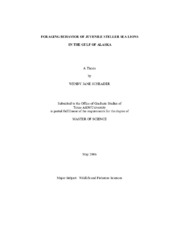| dc.contributor.advisor | Horning, Markus | |
| dc.contributor.advisor | Wursig, Bernd | |
| dc.creator | Schrader, Wendy Jane | |
| dc.date.accessioned | 2007-09-17T19:38:09Z | |
| dc.date.available | 2007-09-17T19:38:09Z | |
| dc.date.created | 2003-05 | |
| dc.date.issued | 2007-09-17 | |
| dc.identifier.uri | https://hdl.handle.net/1969.1/5922 | |
| dc.description.abstract | Relating the behavior of predators to prey density is an important aspect of foraging
theory. Changes in prey accessibility may have contributed to a greater-than 80%
decline in Steller sea lions (Eumetopias jubatus) throughout the western portion of their
range during the last 30 years. A new method was developed for inferring prey
accessibility to juveniles of this otariid, from observable features of diving and ranging
behavior. Seventeen juveniles (9F, 8M) were monitored in multiple seasons and
locations in the Gulf of Alaska via satellite telemetry. Twelve of the 17 had experienced
1-3 months of temporary captivity. Effects of temporary captivity on endurance, habitat
use and development of diving and ranging behavior were tested. Diving and ranging
patterns of previously captive juveniles were consistent with data reported for freeranging
juveniles. Development in mean dive depth and duration after release was likely
due to increased foraging. "Focus in time spent at depth" was tested as a proxy for prey
accessibility using predictions based on foraging theory. 'Focus...' was defined as
vertical concentration in dive distribution and was calculated by comparing the observed
time spent at depth with an expected distribution. There was significantly more focus in summer than winter, and more focus at depth (>62 m) in winter. Focus at depth was
significantly greater during midday for juveniles monitored in winter. Significant
negative correlation between maximum focus and trip duration provided the best
indication that focus may be related to prey accessibility. Short trips had significantly
greater maximum focus than long trips, using a matched-pairs approach. Analysis of
focus in time-at-depth data can elucidate small scale interactions between juvenile
otariids and their prey. This new method of measuring the dive behavior of otariids can
be applied to individual foraging trips and holds promise as a proxy for assessing
seasonal, annual and developmental changes in individual prey accessibility. | en |
| dc.format.extent | 2308511 bytes | en |
| dc.format.medium | electronic | en |
| dc.format.mimetype | application/pdf | |
| dc.language.iso | en_US | |
| dc.publisher | Texas A&M University | |
| dc.subject | diving | en |
| dc.subject | ranging | en |
| dc.title | Foraging behavior of juvenile steller sea lions in the Gulf of Alaska | en |
| dc.type | Book | en |
| dc.type | Thesis | en |
| thesis.degree.department | Wildlife and Fisheries Sciences | en |
| thesis.degree.discipline | Wildlife and Fisheries Sciences | en |
| thesis.degree.grantor | Texas A&M University | en |
| thesis.degree.name | Master of Science | en |
| thesis.degree.level | Masters | en |
| dc.contributor.committeeMember | Biggs, Doug | |
| dc.contributor.committeeMember | Gelwick, Fran | |
| dc.type.genre | Electronic Thesis | en |
| dc.type.material | text | en |
| dc.format.digitalOrigin | born digital | en |


